Qingwen Bu
UniVLA: Learning to Act Anywhere with Task-centric Latent Actions
May 09, 2025Abstract:A generalist robot should perform effectively across various environments. However, most existing approaches heavily rely on scaling action-annotated data to enhance their capabilities. Consequently, they are often limited to single physical specification and struggle to learn transferable knowledge across different embodiments and environments. To confront these limitations, we propose UniVLA, a new framework for learning cross-embodiment vision-language-action (VLA) policies. Our key innovation is to derive task-centric action representations from videos with a latent action model. This enables us to exploit extensive data across a wide spectrum of embodiments and perspectives. To mitigate the effect of task-irrelevant dynamics, we incorporate language instructions and establish a latent action model within the DINO feature space. Learned from internet-scale videos, the generalist policy can be deployed to various robots through efficient latent action decoding. We obtain state-of-the-art results across multiple manipulation and navigation benchmarks, as well as real-robot deployments. UniVLA achieves superior performance over OpenVLA with less than 1/20 of pretraining compute and 1/10 of downstream data. Continuous performance improvements are observed as heterogeneous data, even including human videos, are incorporated into the training pipeline. The results underscore UniVLA's potential to facilitate scalable and efficient robot policy learning.
AgiBot World Colosseo: A Large-scale Manipulation Platform for Scalable and Intelligent Embodied Systems
Mar 09, 2025Abstract:We explore how scalable robot data can address real-world challenges for generalized robotic manipulation. Introducing AgiBot World, a large-scale platform comprising over 1 million trajectories across 217 tasks in five deployment scenarios, we achieve an order-of-magnitude increase in data scale compared to existing datasets. Accelerated by a standardized collection pipeline with human-in-the-loop verification, AgiBot World guarantees high-quality and diverse data distribution. It is extensible from grippers to dexterous hands and visuo-tactile sensors for fine-grained skill acquisition. Building on top of data, we introduce Genie Operator-1 (GO-1), a novel generalist policy that leverages latent action representations to maximize data utilization, demonstrating predictable performance scaling with increased data volume. Policies pre-trained on our dataset achieve an average performance improvement of 30% over those trained on Open X-Embodiment, both in in-domain and out-of-distribution scenarios. GO-1 exhibits exceptional capability in real-world dexterous and long-horizon tasks, achieving over 60% success rate on complex tasks and outperforming prior RDT approach by 32%. By open-sourcing the dataset, tools, and models, we aim to democratize access to large-scale, high-quality robot data, advancing the pursuit of scalable and general-purpose intelligence.
Towards Synergistic, Generalized, and Efficient Dual-System for Robotic Manipulation
Oct 10, 2024

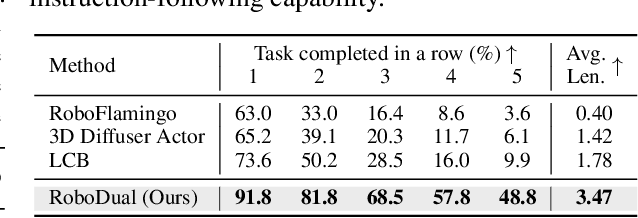

Abstract:The increasing demand for versatile robotic systems to operate in diverse and dynamic environments has emphasized the importance of a generalist policy, which leverages a large cross-embodiment data corpus to facilitate broad adaptability and high-level reasoning. However, the generalist would struggle with inefficient inference and cost-expensive training. The specialist policy, instead, is curated for specific domain data and excels at task-level precision with efficiency. Yet, it lacks the generalization capacity for a wide range of applications. Inspired by these observations, we introduce RoboDual, a synergistic dual-system that supplements the merits of both generalist and specialist policy. A diffusion transformer-based specialist is devised for multi-step action rollouts, exquisitely conditioned on the high-level task understanding and discretized action output of a vision-language-action (VLA) based generalist. Compared to OpenVLA, RoboDual achieves 26.7% improvement in real-world setting and 12% gain on CALVIN by introducing a specialist policy with merely 20M trainable parameters. It maintains strong performance with 5% of demonstration data only, and enables a 3.8 times higher control frequency in real-world deployment. Code would be made publicly available. Our project page is hosted at: https://opendrivelab.com/RoboDual/
Closed-Loop Visuomotor Control with Generative Expectation for Robotic Manipulation
Sep 13, 2024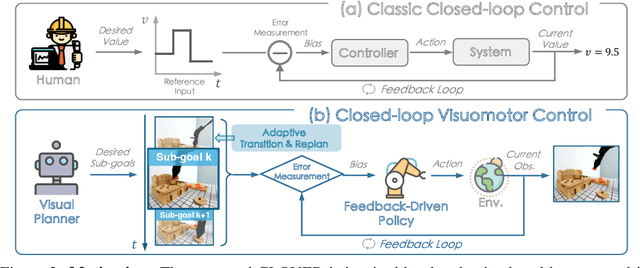



Abstract:Despite significant progress in robotics and embodied AI in recent years, deploying robots for long-horizon tasks remains a great challenge. Majority of prior arts adhere to an open-loop philosophy and lack real-time feedback, leading to error accumulation and undesirable robustness. A handful of approaches have endeavored to establish feedback mechanisms leveraging pixel-level differences or pre-trained visual representations, yet their efficacy and adaptability have been found to be constrained. Inspired by classic closed-loop control systems, we propose CLOVER, a closed-loop visuomotor control framework that incorporates feedback mechanisms to improve adaptive robotic control. CLOVER consists of a text-conditioned video diffusion model for generating visual plans as reference inputs, a measurable embedding space for accurate error quantification, and a feedback-driven controller that refines actions from feedback and initiates replans as needed. Our framework exhibits notable advancement in real-world robotic tasks and achieves state-of-the-art on CALVIN benchmark, improving by 8% over previous open-loop counterparts. Code and checkpoints are maintained at https://github.com/OpenDriveLab/CLOVER.
Learning Manipulation by Predicting Interaction
Jun 01, 2024



Abstract:Representation learning approaches for robotic manipulation have boomed in recent years. Due to the scarcity of in-domain robot data, prevailing methodologies tend to leverage large-scale human video datasets to extract generalizable features for visuomotor policy learning. Despite the progress achieved, prior endeavors disregard the interactive dynamics that capture behavior patterns and physical interaction during the manipulation process, resulting in an inadequate understanding of the relationship between objects and the environment. To this end, we propose a general pre-training pipeline that learns Manipulation by Predicting the Interaction (MPI) and enhances the visual representation.Given a pair of keyframes representing the initial and final states, along with language instructions, our algorithm predicts the transition frame and detects the interaction object, respectively. These two learning objectives achieve superior comprehension towards "how-to-interact" and "where-to-interact". We conduct a comprehensive evaluation of several challenging robotic tasks.The experimental results demonstrate that MPI exhibits remarkable improvement by 10% to 64% compared with previous state-of-the-art in real-world robot platforms as well as simulation environments. Code and checkpoints are publicly shared at https://github.com/OpenDriveLab/MPI.
Embodied Understanding of Driving Scenarios
Mar 07, 2024

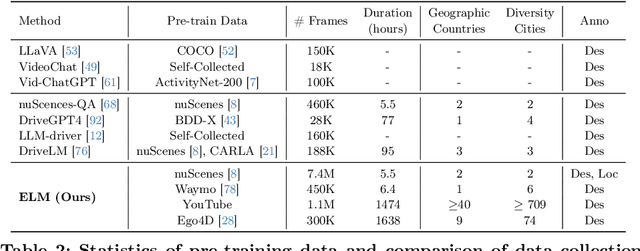

Abstract:Embodied scene understanding serves as the cornerstone for autonomous agents to perceive, interpret, and respond to open driving scenarios. Such understanding is typically founded upon Vision-Language Models (VLMs). Nevertheless, existing VLMs are restricted to the 2D domain, devoid of spatial awareness and long-horizon extrapolation proficiencies. We revisit the key aspects of autonomous driving and formulate appropriate rubrics. Hereby, we introduce the Embodied Language Model (ELM), a comprehensive framework tailored for agents' understanding of driving scenes with large spatial and temporal spans. ELM incorporates space-aware pre-training to endow the agent with robust spatial localization capabilities. Besides, the model employs time-aware token selection to accurately inquire about temporal cues. We instantiate ELM on the reformulated multi-faced benchmark, and it surpasses previous state-of-the-art approaches in all aspects. All code, data, and models will be publicly shared.
AgentCoder: Multi-Agent-based Code Generation with Iterative Testing and Optimisation
Dec 20, 2023



Abstract:The advancement of natural language processing (NLP) has been significantly boosted by the development of transformer-based large language models (LLMs). These models have revolutionized NLP tasks, particularly in code generation, aiding developers in creating software with enhanced efficiency. Despite their advancements, challenges in balancing code snippet generation with effective test case generation and execution persist. To address these issues, this paper introduces Multi-Agent Assistant Code Generation (AgentCoder), a novel solution comprising a multi-agent framework with specialized agents: the programmer agent, the test designer agent, and the test executor agent. During the coding procedure, the programmer agent will focus on the code generation and refinement based on the test executor agent's feedback. The test designer agent will generate test cases for the generated code, and the test executor agent will run the code with the test cases and write the feedback to the programmer. This collaborative system ensures robust code generation, surpassing the limitations of single-agent models and traditional methodologies. Our extensive experiments on 9 code generation models and 12 enhancement approaches showcase AgentCoder's superior performance over existing code generation models and prompt engineering techniques across various benchmarks. For example, AgentCoder achieves 77.4% and 89.1% pass@1 in HumanEval-ET and MBPP-ET with GPT-3.5, while SOTA baselines obtain only 69.5% and 63.0%.
SRFormer: Empowering Regression-Based Text Detection Transformer with Segmentation
Aug 21, 2023
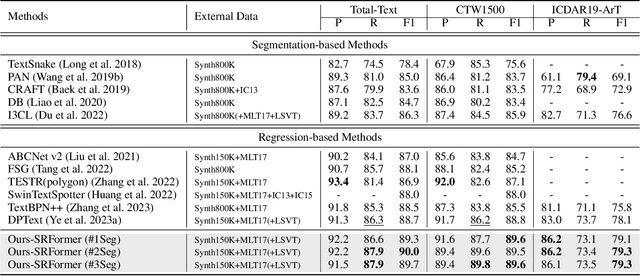
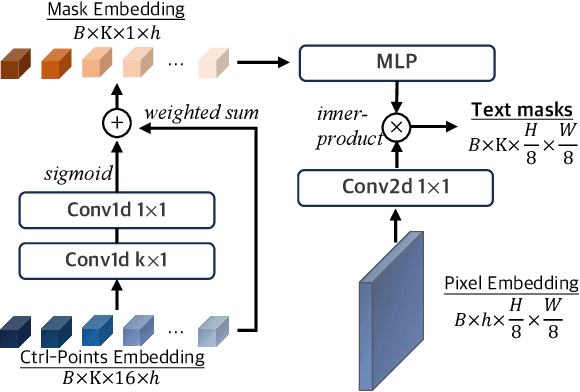

Abstract:Existing techniques for text detection can be broadly classified into two primary groups: segmentation-based methods and regression-based methods. Segmentation models offer enhanced robustness to font variations but require intricate post-processing, leading to high computational overhead. Regression-based methods undertake instance-aware prediction but face limitations in robustness and data efficiency due to their reliance on high-level representations. In our academic pursuit, we propose SRFormer, a unified DETR-based model with amalgamated Segmentation and Regression, aiming at the synergistic harnessing of the inherent robustness in segmentation representations, along with the straightforward post-processing of instance-level regression. Our empirical analysis indicates that favorable segmentation predictions can be obtained at the initial decoder layers. In light of this, we constrain the incorporation of segmentation branches to the first few decoder layers and employ progressive regression refinement in subsequent layers, achieving performance gains while minimizing additional computational load from the mask. Furthermore, we propose a Mask-informed Query Enhancement module. We take the segmentation result as a natural soft-ROI to pool and extract robust pixel representations, which are then employed to enhance and diversify instance queries. Extensive experimentation across multiple benchmarks has yielded compelling findings, highlighting our method's exceptional robustness, superior training and data efficiency, as well as its state-of-the-art performance.
CodeCoT and Beyond: Learning to Program and Test like a Developer
Aug 17, 2023



Abstract:In natural language processing, transformer-based large language models (LLMs) like GPT-x models developed by OpenAI have revolutionized the landscape. Despite their impressive capabilities, these models often encounter challenges when handling tasks that differ from their training data, resulting in compromised performance. To address this, few-shot learning has emerged as a valuable technique, allowing LLMs to adapt with minimal task-specific data. One innovative strategy, known as Chain-of-Thought Prompting (CoT), has been introduced to guide LLMs in revealing cognitive processes during multi-step reasoning. In this paper, we propose Code Chain-of-Thought~(CodeCoT), which consists of two components: the Vanilla CodeCoT and the Self-exam CodeCoT. The latter incorporates self-examination, empowering the model to iteratively generate code, formulate test cases, and refine its outputs. Specifically, the process entails the generation of test examples by the model corresponding to the code it is tasked to implement. If it fails on the test examples, then it regenerates the code based on the erroneous code and associated error types. Through comprehensive experiments, we observed that both techniques significantly enhance code generation accuracy across various LLM variants. Our evaluation results reveal that CodeCoT improves the code generation effectiveness, including an unprecedented pass@1 accuracy of 79.27\% using the Self-exam CodeCoT approach on the gpt-3.5-turbo-0613 model in the HumanEval dataset.
Towards Building More Robust Models with Frequency Bias
Jul 28, 2023



Abstract:The vulnerability of deep neural networks to adversarial samples has been a major impediment to their broad applications, despite their success in various fields. Recently, some works suggested that adversarially-trained models emphasize the importance of low-frequency information to achieve higher robustness. While several attempts have been made to leverage this frequency characteristic, they have all faced the issue that applying low-pass filters directly to input images leads to irreversible loss of discriminative information and poor generalizability to datasets with distinct frequency features. This paper presents a plug-and-play module called the Frequency Preference Control Module that adaptively reconfigures the low- and high-frequency components of intermediate feature representations, providing better utilization of frequency in robust learning. Empirical studies show that our proposed module can be easily incorporated into any adversarial training framework, further improving model robustness across different architectures and datasets. Additionally, experiments were conducted to examine how the frequency bias of robust models impacts the adversarial training process and its final robustness, revealing interesting insights.
 Add to Chrome
Add to Chrome Add to Firefox
Add to Firefox Add to Edge
Add to Edge